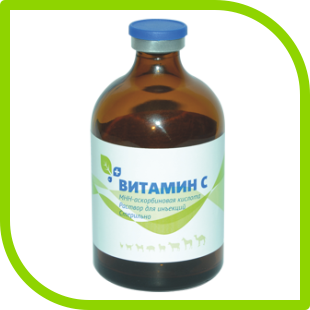INSTRUCTIONS
of using Vitamin C” for animals
(Organization-developer: “BioKhimPharm”, Raduzhny, Vladimir region).
I. General information
1. Trade name: Vitamin C.
International Nonproprietary Name: Acidum ascorbinicum.
2. Dosage form: solution for injection. Vitamin C in 1 ml as an active ingredient 50 mg of ascorbic acid (vitamin C), as well as sodium bicarbonate and sodium metabisulphite auxiliaries, and water for injections – up to 1 ml. Produce Vitamin C prepacked in 5, 10, 20, 50 and 100 ml in glass bottles of the appropriate capacity, sealed with rubber stoppers, reinforced aluminum caps.
3. Each bottle is labeled with the name of the medicinal product, serial number, volume, expiration date. Each bottle or bottle is labeled with the indication of: the manufacturing organization, its address and trademark, the purpose of the medicinal product, the name and content of the active substance, the method of application, the serial number, the date of manufacture, the expiration date, the volume in the vial or bottle, storage conditions, “Sterile”, “For veterinary use”, state registration numbers, information on the confirmation of compliance, designation of technical specifications and provide instructions for use.
Shelf life of the medicinal product under the conditions of storage in closed containers is 2 years from the date of manufacture.
It is prohibited to use Vitamin C after the expiration date.
4. Store the medicinal product in the manufacturer’s closed packaging in a dry, protected from light place, at a temperature from 00С to 25 0С.
5. Keep Vitamin C out of the reach of children.
6. Dispose of unused product with expired shelf life in accordance with legal requirements.
II. Pharmacological properties
7. Pharmacotherapeutic group: Vitamin.
Vitamin C has pronounced reducing properties, takes part in carbohydrate, protein and fat metabolism, stimulates the recovery of cells and tissues, and participates in the synthesis of steroid hormones in the body. As ascorbic acid affects the permeability of membranes of cells of organs and tissues, determines the structure of the vascular walls. In the presence of an inflammatory process and a change in pH in this place, vitamin C acidifies the pH. It has antioxidant properties.
Vitamin C according to the classification of GOST 12.1.007-76 refers to substances of 4 hazard classes – low-hazard substances. The drug in recommended doses is not toxic for warm-blooded animals.
III. The order of application
8. Patients and weakened animals, in complex therapy for viral and bacterial diseases, puppies and kittens at birth, if a history of offspring has weakness and hypoxia. Assign the same way to cardiac patients, oncology and patients on the course of chemotherapy. Used in the presence of bleeding, postoperative complications, chronic renal failure in dogs and cats. In the complex theory with avitaminosis.
9. Contraindications: individual intolerance, increased coagulability of blood, the presence of clots in large vessels.
10. Vitamin C is administered parenterally – intramuscularly or intravenously. Doses are calculated individually, based on the etiology of the pathological process (minimum dose of 0.1-0.2 ml per kg of animal weight).
Approximate doses to animals for intravenous administration (mg of active ingredient per 1 kg of live weight): horses 0.5-1.5 mg, cattle 1.25-5 mg, dogs 0.02-0.05 mg.
With a long course of treatment, it is also possible to take the drug orally in a tablet form.
11. Symptoms of overdose with the use of the drug in accordance with the instructions for use are not revealed.
12. Features of the drug at the beginning of application or its cancellation is not established.
13. Failure to comply with the recommended interval with repeated administration of the drug may lead to a decrease in its effectiveness. If you skip the next dose of the drug, its use is resumed as soon as possible in the same dosage and according to the same scheme.
14. At recommended doses, Vitamin C does not cause side effects and complications in animals.
15. Ascorbic acid increases absorption of penicillin, iron. Incompatible with cyanocobalamin.
16. Livestock products during and after Vitamin C use are used without restrictions.
IV. Personal prevention measures
17. When working with Vitamin C, you should observe the general rules of personal hygiene and safety, provided for when working with medications.
18. When working with the drug, it is forbidden to drink, smoke and eat. After working with the drug, wash your hands with soap and water. Empty containers from the preparation are forbidden to use for household purposes; it must be disposed of with household waste.
19. If the product gets on the skin and / or mucous membranes, they should be rinsed with plenty of running water. If accidentally swallowed, give a large amount of water to drink (4-5 glasses) and induce vomiting. In case of allergic reactions, you should immediately contact a medical institution (with instructions for the use of the drug and a label).









